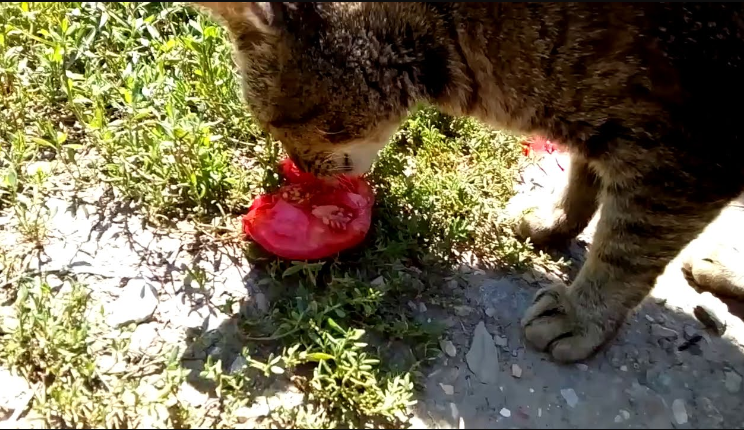Can Cats Eat Tomatoes Safely? What You Need To Know

Cats can eat ripe tomatoes in moderation. However, unripe tomatoes and plant leaves are toxic to them due to solanine.
Cats and tomatoes may not seem like a natural pairing, but pet owners often wonder about the safety of feeding human foods to their feline friends. While a bite of ripe tomato flesh occasionally might not harm your cat, it’s crucial to avoid green tomatoes and the plant itself.
Tomatoes belong to the nightshade family, plants known for containing substances that can harm pets. As obligate carnivores, cats have specific dietary needs, which means that vegetables, even non-toxic ones, are not essential to their diet. Thus, while an occasional trim, well-washed piece of ripe tomato can be a harmless treat, tomatoes should not be a staple in your cat’s diet. Always consult your veterinarian before introducing new foods to your cat’s diet to ensure their health and well-being.
Contents
- 1 Feline Culinary Adventures: Are Tomatoes In The Menu?
- 2 Tomatoes Decoded: What’s In The Red Sphere?
- 3 Unripe Vs Ripe Tomatoes: A Tale Of Safety
- 4 Serving Tomatoes To Cats: A How-to Guide
- 5 When Tomatoes Turn Troublesome: Risks And Reactions
- 6 Integrating Tomatoes Into Cat Diets: Experts Weigh In
- 7 Tomato-based Products And Cats: Navigating The Aisles
- 8 The Great Tomato Debate: Feline Myths Vs Facts
- 9 Alternatives To Tomatoes In Cat Treats
- 10 Conclusion
Feline Culinary Adventures: Are Tomatoes In The Menu?
Owners often wonder what foods are safe for their feline friends. Cats show interest in our meals, sparking curiosity about sharing. One common question is whether cats can eat tomatoes. This post dives into the heart of feline dietary do’s and don’ts, focusing on the red, ripe, and tantalizing tomato.
The Curiosity Of Cats Towards Human Food
Cats’ fascination with human food is a tale as old as time. The sight or smell of our meals can trigger a cat’s curiosity. Should they nibble on that juicy piece you dropped? Knowing what’s safe is crucial for their health. Let’s explore the specifics of cats and tomatoes.
Tomato: Fruit Or Vegetable In A Cat’s World?
Despite being botanically a fruit, tomatoes often raise eyebrows in the discussion of the feline diet. As obligate carnivores, cats don’t naturally seek fruits or vegetables. Yet, the occasional tomato piece might pique their interest. But is it safe?
A ripe tomato itself isn’t toxic. However, the plant’s leaves and stems contain solanine—which is harmful to cats. It’s best served as an occasional treat and never as a meal substitute.
| Cat-Safe Parts of a Tomato | |
| Tomato Part | Safe for Cats? |
| Ripe Tomato Fruit | Yes, in moderation |
| Leaves and Stems | No, it contains solanine |
| Unripe Green Tomatoes | No, it contains solanine |
| Tomato Sauce and Soup | Often No, contains salt and other ingredients |
- Small amounts of ripe tomatoes are generally harmless for cats.
- The green parts of the tomato plant are toxic.
- Avoid tomato-based products like sauces or soups. They often have ingredients harmful to cats.
Tomatoes Decoded: What’s In The Red Sphere?
Tomatoes, bright and alluring, entice both humans and pets alike. These juicy globes pack a flavorful punch. But are they safe for your feline friends? Understanding what lies beneath that shiny red exterior is crucial for cat owners. It’s time to unravel the mysteries of the humble tomato.
Essential Nutrients Found In Tomatoes
Tomatoes brim with essential vitamins and minerals that are good for us. But what about cats? Here’s what these red fruits contain:
- Vitamin C: Boosts immune health.
- Vitamin A: Important for vision and skin.
- Potassium: Keeps heart and muscles working well.
- Folate: Helps with cell growth and function.
While these nutrients sound beneficial, cats get these from their balanced meat-based diets. Extra from tomatoes isn’t necessary.
Potential Toxins Lurking For Cats
Tomatoes belong to the nightshade family and contain compounds that could harm cats.
Solanine:
It is found in the green parts of tomatoes and is toxic to cats.
Alpha-tomatine:
A glycoalkaloid in stems and leaves is dangerous for cats.
Cats nibbling on ripe tomatoes may be safe, but stems, leaves or unripe tomatoes could cause trouble.
Unripe Vs Ripe Tomatoes: A Tale Of Safety
Tomatoes stir up quite the mystery in the feline world. Not all tomatoes are created equal for your furry friends. The stage of ripeness plays a crucial role. Let’s explore the tomato conundrum and make mealtime safe for your cat!
Green Menace: Solanine In Unripe Tomatoes
Why give a pause before sharing that green tomato? Unripe tomatoes come packed with solanine, a substance not friendly to your cat’s health. Solanine can cause gastrointestinal upset, among other nasties. The symptoms of its ingestion include:
- Stomach ache
- Heart problems
- Confusion
Keep those green tomatoes far out of Whisker’s reach!
Ripe And Ready: Safer For Feline Consumption?
Once tomatoes turn red, they are lower in solanine. This means they’re safer for your cat. But does ‘safer’ mean ‘safe’? Surprising for many, ripe tomatoes are still a treat to offer only in moderation. Cats don’t digest plant material as we do. Hence, stick to cat-specific fruits and veggies.
| Tomato Type | Solanine Content | Safe for Cats? |
| Unripe/Green | High | No |
| Ripe/Red | Low to None | In Moderation |
Introduce ripe tomatoes slowly and always without stems or leaves. If in doubt, consult your vet.
Serving Tomatoes To Cats: A How-to Guide
Cats often spark curiosity about what they can or cannot eat. Exploring tomato serving for cats is a journey not all pet owners consider. Gain insights into how safely offering tomatoes to your feline friends can add variety to their diet. Master the art of serving tomatoes in this straightforward guide.
Prepping Tomatoes For Your Furry Friend
Before serving tomatoes, ensure the fruit is ripe and accessible from green parts. Green tomatoes contain solanine, which is dangerous for cats. Wipe the tomato clean, removing any pesticide traces. Start by peeling off the skin, as it can be challenging for cats to digest. Remove seeds as a precaution. Chop the flesh into small, bite-sized pieces to prevent choking.
- Choose ripe, red tomatoes: Only use those without green spots or stalks.
- Clean thoroughly: Wash away any chemicals or dirt.
- Peel and deseed: Simplify digestion and remove any harmful parts.
- Cut into small pieces: Fit pieces comfortably in a cat’s mouth.
Appropriate Serving Sizes And Frequency
Tomatoes should only be occasional treats, not regular diet staples. Start with a small piece to test your cat’s tolerance. Monitoring any unusual behaviour or stomach upset is essential. Refer to the table below for a quick guide on appropriate serving sizes and frequency.
| Cat Size | Serving Size | Frequency |
| Small | One small piece | Once a week |
| Medium | Two small pieces | Once a week |
| Large | Three small pieces | Every other week |
Remember, each cat is different. Some may enjoy tomatoes; others may dislike them. Always offer tomatoes as a minor part of the diet and under supervision. Consult your veterinarian before introducing new foods to your cat’s meal plan.
When Tomatoes Turn Troublesome: Risks And Reactions
Tomatoes might be a staple in human diets, but they can spell trouble for our feline friends. Cats are often curious creatures drawn to the bright red fruit, but not all parts of a tomato are safe. Understanding the risks and how to react can keep your pet healthy. Here, we delve into what symptoms to look out for and what steps to take if a cat ingests a rotten tomato.
Recognizing Symptoms Of Tomato Toxicity
It’s crucial to know the signs of tomato toxicity in cats. Symptoms can vary depending on the part of the tomato ingested and the amount consumed. Keep a watchful eye on your cat if they sneak a bite of tomato. A table summarizing the possible symptoms:
| Part of Tomato | Symptoms |
| Leaves/Stem | Gastrointestinal upset, drooling, loss of appetite |
| Green Tomato | Drowsiness, behavioural change, slow heart rate |
| Ripe tomato | Usually safe in small amounts but can cause stomach discomfort |
Immediate Actions To Take If Your Cat Eats A Bad Tomato
If your cat consumes a lousy tomato, act fast for their safety. Here’s a list of immediate actions:
- Remove any remaining tomato from your cat’s reach.
- Observe your cat for any signs of distress or symptoms.
- Contact your vet promptly, especially if symptoms develop.
- Follow the vet’s instructions — it might involve monitoring at home or an emergency visit.
Cats might explore tomatoes out of curiosity. Yet, ripe, raw tomatoes in tiny amounts can sometimes be safe. Always err on the side of caution, though. Be aware of the risks and ensure your pet’s well-being with quick action if needed.
Integrating Tomatoes Into Cat Diets: Experts Weigh In
Cat owners often wonder about the safety of feeding their feline friends foods meant for humans. Tomatoes, an everyday kitchen staple, raise questions about their place in a cat’s diet. Here, experts provide insights and advice on this topic.
Veterinary Perspectives On Tomatoes As Cat Food
Many veterinarians practice caution when it comes to cats and tomatoes. While ripe tomatoes are not toxic to cats, green parts of the tomato plant can be harmful. These parts contain a substance called solanine, which can cause gastrointestinal upset in pets.
- Ripe tomatoes: Only in moderation
- Green parts: Avoid completely
- Cooked tomatoes: Safer than raw
Remove all stems and leaves before offering your cat a small piece of tomato. Always opt for cooked tomatoes over raw tomatoes to reduce the risk of stomach issues.
Nutritional Balance And Dietary Needs Of Cats
Cats are obligate carnivores. This means their diet should primarily consist of protein. Tomatoes do not provide the essential nutrients cats need. Instead, their meals should include a balance of:
| Nutrient | Source |
| Protein | Meat, fish |
| Fats | Animal fats |
| Vitamins | Quality commercial cat food |
| Minerals | Cat food and supplements |
Tomatoes offer minimal benefits to cats and should not replace any part of their balanced diet. If you choose to give tomatoes to cats, do so sparingly, and always consult with your veterinarian.
Remember, treats, including those of the tomato variety, should constitute no more than 10% of a cat’s daily caloric intake.
Cat owners often wonder what foods are safe for their feline friends. Tomato-based products and cats present a tricky aisle to navigate. Whole tomatoes might seem harmless, but many tomato-based products include ingredients that could harm your cat. Let’s explore how to keep your kitty safe while considering these everyday grocery items.
Canned, Cooked, And Condiment Forms: Safe Or Not?
Not all tomato products are created equal regarding your cat’s health. Canned tomatoes often come with extra salt and preservatives, which are not ideal for your pet. Cooked tomatoes themselves may not harm your cat, but the additional spices and ingredients often found in them can.
- Canned Tomato Sauce Might contain onions, garlic, or other harmful ingredients. Avoid giving this to your cat.
- Tomato Soup: Usually has dairy and excessive sodium. It is not recommended for feline diets.
- Cooked Pasta Sauce: This can include a mix of spices and herbs that may be toxic to cats.
The Ketchup Conundrum: Can Cats Handle Condiments?
Vibrant and tangy ketchup sits on almost every table, but can cats handle ketchup? The answer is complex. Ketchup is high in sugar and sodium, which are unsuitable for cats. This condiment also sometimes contains onions or garlic powder, both harmful to feline health.
| Condiment | Is It Safe? |
| Plain Ketchup | Best avoided – high sugar and salt content |
| Flavored Ketchup | No – potential toxins like onion/garlic |
| BBQ Sauce | No – contains harmful spices and sugar |
| Salad Dressing | No – may include onions, garlic, or chives |
The Great Tomato Debate: Feline Myths Vs Facts
The Great Tomato Debate: Feline Myths vs Facts stirs up a curious bowl of questions for cat owners. Can cats safely enjoy this everyday garden treat, or should tomatoes be scratched off the menu? Let’s unravel the tangled vine of tales surrounding tomatoes and our feline friends.
Debunking Tomato Tales In The Cat Community
Many cat owners ponder over the safety of tomatoes for their pets. Misinformation often leads to confusion. Here are the myths and the truths:
- Myth: All tomato parts are toxic to cats.
- Fact: Ripe tomato flesh is generally safe in moderation.
- Myth: Cats benefit from tomatoes nutritionally.
- Fact: Cats are obligate carnivores; they require a meat-based diet.
- Myth: Tomato sauce is a good treat for cats.
- Fact: Sauces may contain harmful ingredients like onions and garlic.
Scientific Studies On Cats And Tomato Consumption
Research provides insight into how tomatoes affect cats:
| Study Focus | Findings | Implications |
| Ripe Tomatoes | Minimal risk when ingested in small amounts | Occasional ripe tomatoes are not harmful |
| Green Plant Parts | Contain solanine, which is toxic | Avoid leaves, stems, and unripe tomatoes |
| Long-term Effects | There is no conclusive data on regular tomato intake | Moderation is vital; it is not a dietary staple |
Ripe tomatoes can occasionally land on your cat’s plate in small bits. Remember, green parts of the tomato plant are off-limits. Always prioritize a balanced diet tailored for cats and consult with a vet for personalized advice.
Alternatives To Tomatoes In Cat Treats
Many cat owners wonder about giving tomatoes to their furry friends. While some parts of the tomato plant can be harmful, pet parents seek safe alternatives. This section explores various options to keep cats happy and healthy without the risks tomatoes pose.
Safe And Healthy Snack Options For Cats
Cats need snacks that are safe and beneficial for their health.
- Lean Meats: Chicken, turkey, and lean beef are excellent protein sources.
- Fish: Occasional servings of tuna or salmon can be a treat.
- Commercial Cat Treats: Specially formulated treats ensure nutritional balance.
- Cooked Eggs: Eggs are high in protein and are an excellent cooked snack.
- Special Cat Grass: Wheatgrass or oat grass can stimulate digestion.
- Cantaloupe: Small pieces provide hydration and vitamins.
Homemade Treat Recipes Without The Red Risk
Crafting homemade treats can be a fun way to bond with your cat. Below are simple, tomato-free recipes.
- Tuna Patties: Combine canned tuna, eggs, flour, and water. Bake until firm.
- Chicken Jerky: Slice chicken breast thinly and bake at a low temp until dry.
- Fishy Bites: Mix salmon, cat-safe fish oil, and mashed peas. Form into small balls and chill.
- Eggcellent Snacks: Mix scrambled eggs with cooked carrots. Roll into bite-sized treats.
Conclusion
To wrap up, while tomatoes might not be toxic to cats, they’re not an ideal snack either. It’s crucial to prioritize cat-safe foods and consult your vet about dietary changes. Remember, moderation is vital; your feline friend will thrive with a well-balanced diet.
>>Also Read About: Can Dogs Eat Dragon Fruit?



